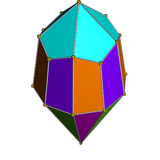Elongated_pentagonal_cupola
Elongated pentagonal cupola
20th Johnson solid
In geometry, the elongated pentagonal cupola is one of the Johnson solids (J20). As the name suggests, it can be constructed by elongating a pentagonal cupola (J5) by attaching a decagonal prism to its base. The solid can also be seen as an elongated pentagonal orthobicupola (J38) with its "lid" (another pentagonal cupola) removed.
A Johnson solid is one of 92 strictly convex polyhedra that is composed of regular polygon faces but are not uniform polyhedra (that is, they are not Platonic solids, Archimedean solids, prisms, or antiprisms). They were named by Norman Johnson, who first listed these polyhedra in 1966.[1]



